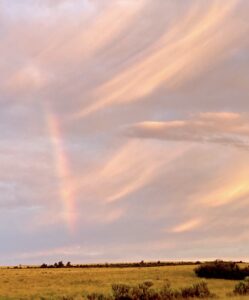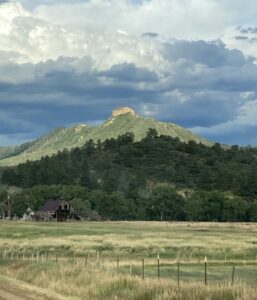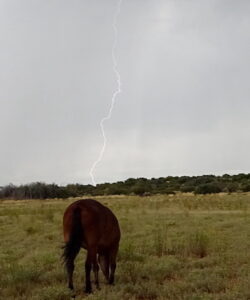Editor’s Note: This is an unedited version of Maddy Butcher’s opinion piece that appeared in the Washington Post.

Of the four images for this post, only this one is of public lands. The other pics are of private lands.
Maddy Butcher writes:
There was a whole lot of hootin’ and hollerin’ when, earlier this summer, the judge at the federal district court in Casper, Wyoming, ruled in favor of four hunters, dismissing the civil case brought against them by a wealthy landowner from North Carolina. The hunters had “corner crossed.” Like checker pieces on a game board, they had crossed diagonally from one public land parcel to another. They didn’t touch the North Carolinian’s ranch land, but he maintained that they had entered his airspace and therefore trespassed, to the tune of over seven million dollars in damages.
For a moment, it seemed the little guy and public land access advocates had won.
But, wait.
In Colorado, an angler lost a related battle when the state Supreme Court ruled in favor of the landowner. Even though the Arkansas River seems like a historic public way, when it flows through private land, it’s not okay to wade it, the court ruled. Meanwhile, in New Mexico, it is okay. In Utah, it depends.
Across the west, courts are reflecting the strained and knotted duality between public trust and private land ownership. Some cast it as simple battles of rich versus poor, or of locals versus out-of-towners. But it’s not so simple.
 As outdoor recreation increasingly fuels economies here and as landowners assert their rights, the fights – not just in courts, but across streams, fencelines, and dirt paths – will continue.
As outdoor recreation increasingly fuels economies here and as landowners assert their rights, the fights – not just in courts, but across streams, fencelines, and dirt paths – will continue.
One colleague compared this moment to the gold and silver rushes over a century ago, when mining quickly became a driver of all things economic, cultural, political, and social.
“This is a pivotal moment,” said veteran journalist Jason Blevins when I asked him about the growing impact of nature seekers. “Big shifts are underway.”
It wasn’t long ago that visiting hikers and mountain bikers were considered nuisance breeds here in southwestern Colorado. They all just ate “nuts and berries” said one county commissioner at a meeting I attended, and they couldn’t possibly contribute to the local economy.
That was before the pandemic and before a two-million-dollar shortfall to our county’s budget, due to a bust in oil-and-gas-related income.
 This summer, the county’s newly created Outdoor Recreation Industry Office hosted public workshops to share their findings. Turns out, some two million twiggy bohemians and others spend over $100 million annually in our little corner of the west, according to RPI Consulting, the firm hired to assess those visitors’ economic impact.
This summer, the county’s newly created Outdoor Recreation Industry Office hosted public workshops to share their findings. Turns out, some two million twiggy bohemians and others spend over $100 million annually in our little corner of the west, according to RPI Consulting, the firm hired to assess those visitors’ economic impact.
This should be a good thing. Yet while the realtors, outfitters, and bike shops celebrate, it seems many of us struggle to roll with the good times. Like the courts, when we consider the multifaceted impact of this population flow, we’re conflicted.
While newcomers are nothing new in the west, I feel for communities like Gallatin County in Montana, Madison County in Idaho, and Weld County in northern Colorado, which have grown by whopping 34-43 percent between 2010 and 2020, according to the US Census.
Mountain towns, also known as old mining towns, are particularly challenged with embracing (or not), educating (or not), and planning (or not) for the influx of people who want to get some of that nature in their bones and in their holdings.
 It’s called the amenity trap and at least one research group has funded a study to help communities avoid “being loved to death.”
It’s called the amenity trap and at least one research group has funded a study to help communities avoid “being loved to death.”
There is problem-grappling like that needs to happen on a community level and then there is problem-grappling and education that needs to happen personally:
When I moved to Colorado from Utah, someone handed me The Good Neighbor Guidebook for Colorado. Edited by two lawyers, the book helps readers navigate the laws and customs around fencing, water, wildlife, and livestock. Your dogs can be shot for chasing deer, you can’t divert a stream even a little bit, you must mitigate your noxious weeds, and if you don’t want cattle grazing your place, you’ll have to fence them out.
Locals might also recommend getting a phone app which delineates clearly whether you’re on public or private land. Think signs will guide you? What signs?
If a gate in the wilderness is closed, make sure you leave it closed. And don’t close an open gate (which could keep livestock from water and is a possible felony).
Cluelessness abounds. On public land, I’ve been told to go somewhere else to let my horses and dogs drink, as if this single visitor owned the immediate water access. I’ve seen young hikers in the woods, dressed in tan, during hunting season, unaware that hunting season was a thing. I’ve seen private lands treated like public lands and public lands treated like complimentary vending machines, with visitors taking artifacts, plants, and animals.
Justin Farrell, a Yale sociology professor who grew up in Wyoming, told me, “People think that once you get out of cities, that’s where nature lives. You can go wherever. It’s as if someone moved to another country and didn’t bother reading about its laws and customs,” said Farrell. “But it’s not all national parks here.”
As we twist and turn around boundaries and rights, we might pause to consider problem-grappling on an ecosystem level, too:
The elk, bear, marmots, and coyotes move to places where there is less pressure from human presence. Lately, though, it’s coming at them from all sides.